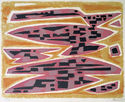
19th, 20th & 21st Century Fine Prints
707-546-7352 · fax 707-546-7924 · web: www.annexgalleries.com · email: artannex@aol.com
Alfred Manessier Biography
Alfred Manessier
French
1911–1993
Biography
Painter, printmaker, and designer Alfred Manessier was born in Saint-Ouen, France, in 1911. His grandfather had been a decorative stonemason and his father and uncle had both attended the Ecole des Boeaux-Arts, yet his father was hesitant to let the budding artist pursue fine art as a career. Instead, he allowed him to go to Paris on the condition that he study architecture. Manessier enrolled at the Academie Ranson in 1929; five years later, after his father died unexpectedly, switched to art courses under Roger Bissiere.
Manessier arrival in the art world was fueled by his interest in abstraction, which was growing in popularity, and his time in the international art hub that was 1930s Paris proved to be fruitful. In 1937 he was invited to take part in the government-appointed avent-garde mural project for the Paris International Exposition, designing four murals for transportation centers. He married painter Therese Simmonet the following year.
Of particular interest to Manessier was the non-figural abstract movement, and in 1941 he participated in the "20 Young Painters" show at Gallery Braun, highlighting the works of artists who chose to do away with representational artwork altogether. The show was popular but it was also the target of right-wing suspicion, as Nazi Germany's occupation took hold of France. An outspoken member of the Young France organization, which worked to plan for a post-Nazi France by positiong artists, writers, and thinkers as teachers, he was nonetheless allowed to exhibit in the show without recourse. Despite this, he fell into a depression owing to the strain of living under occupation, and in 1943 he abandoned teaching and focused entirely on his own art.
At this time he developed the style he would become best known for: mosaic-like compositions with loose geometric organization, in bold colors. By the late 1940s he was receiving commissions for stained glass windows for cathedrals, as well as set and costume deisgns for major theater productions. He also began to explore tapestry, which led to commissions such as a benediction cape for a Nord church.
Among the awards he recieved throughout his career, he was given 1st Prize for Painting at the 1953 Sao Paulo Biennale; 1st Prize, Vienna Exhibition of Sacred Art, 1954; Carnegie Institute International Grand Prize for Contemporary Painting, 1955; International Painting Prize, Valencia Venezuela, 1955; 1st Prize for Engraving, Grenchen Switzerland Triennale, 1958; among others.
Manessier died in Orleans in 1993 after a car accident.
His work can be found in the collections of the Wallraf-Richartz Museum, Cologne; the Nationalgalerie, Berlin; Museo de Arte Moderna, Rio de Janiero; Ministere des Affaires Culturelles; Le Havre Musee; Museum Boymans Van, Rotterdam; Museo Civico, Turin; Musee d'Histoire et d'Art, Luxembourg; Malmo Museum, Malmo; Moderna Museet, Stockholm; the Guggenheim, New York; the Museum of Modern Art, New York; the Phillips Collection, Washington, D.C.; among others.


